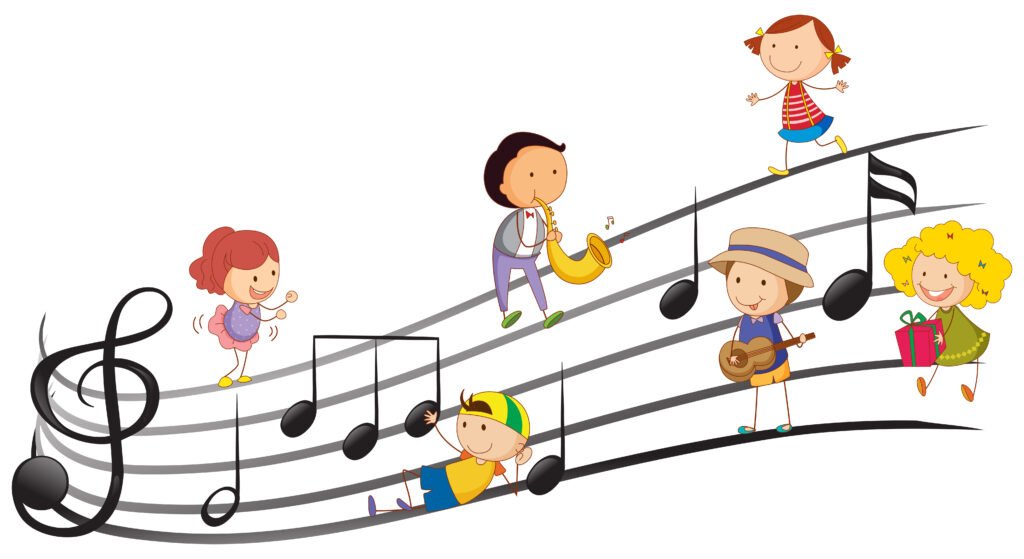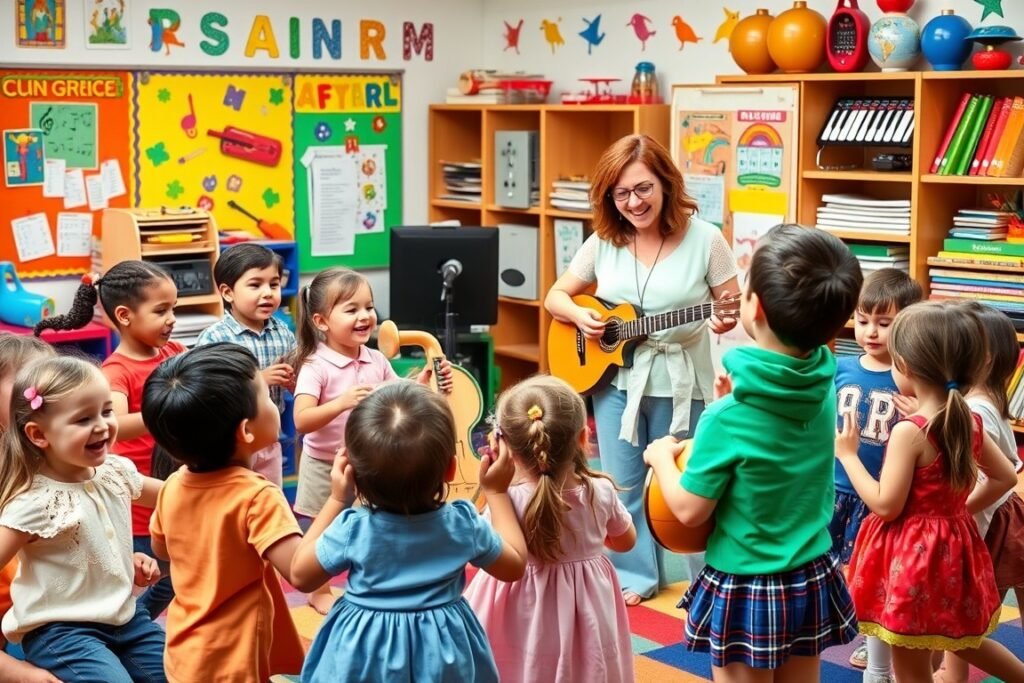
Introduction
Early childhood is a critical period for growth and development, laying the foundation for a child’s future learning, behavior, and health. During these formative years, engaging experiences are essential to foster cognitive, emotional, and physical growth. Among the myriad ways to enrich a child’s early years, music and movement stand out as powerful tools. These elements are not merely sources of entertainment; they play a profound role in shaping a child’s development. In this blog, we’ll explore how incorporating music and movement can enhance early childhood development and discuss strategies for integrating these practices into your educational framework.

1. Cognitive Development
How Music and Movement Stimulate Brain Development
Music and movement are incredibly beneficial for brain development in young children. When children engage with music, they are exposed to a range of auditory experiences that stimulate their cognitive functions. For instance, listening to different melodies and rhythms helps children recognize patterns, which enhances their ability to process and recall information. Movement activities, such as dancing or rhythmic play, encourage the development of motor skills and spatial awareness, further contributing to cognitive growth.

The Role of Rhythm and Patterns in Cognitive Development
Rhythm and patterns are fundamental to both music and movement. They offer children opportunities to anticipate and predict, skills that are crucial for cognitive development. For example, clapping to a beat or following a rhythmic sequence requires children to use their working memory and attention. By recognizing and predicting patterns in music, children strengthen their problem-solving abilities and mathematical thinking. Integrating these activities into early childhood education, such as at the BEST Teacher Training Institute in Mumbai Borivali, can provide educators with effective tools for enhancing cognitive skills.

The Benefits of Learning Through Songs and Rhymes
Songs and rhymes are more than just fun—they are educational tools that support language development and literacy. Singing along to songs helps children develop their vocabulary and phonemic awareness. Rhymes and repetitive lyrics aid in memory retention and language comprehension. Programs at the Best Jolly Phonics Teacher Training Institute in Mumbai Borivali often emphasize the importance of these elements, teaching educators how to use music as a powerful medium for language learning.

2. Emotional Development
The Connection Between Music and Emotions
Music has a profound impact on emotional development. It can evoke a range of feelings, from joy to sadness, providing children with a means to explore and understand their emotions. For instance, listening to soothing music can help calm anxious feelings, while upbeat tunes can uplift and energize. Understanding this connection is essential for fostering emotional intelligence in children.

How Music and Movement Can Help Children Express Themselves
Music and movement offer children creative outlets for self-expression. Through dance, children can express their feelings and experiences in ways that words alone may not capture. Similarly, creating their songs or rhythms allows children to communicate their thoughts and emotions, promoting self-awareness and confidence. Training programs like those at the Best ECCEd Teacher Training Institute in Mumbai Borivali equip educators with strategies to encourage and support this form of expression in the classroom.

The Positive Impact of Music on Social-Emotional Skills
Participating in music and movement activities often involves working with others, which can enhance social-emotional skills. Group activities such as singing in a choir or dancing in a circle teach children about cooperation, turn-taking, and empathy. These social skills are vital for forming healthy relationships and working effectively in group settings. Integrating these practices into the curriculum can be an excellent way to nurture these skills, as demonstrated by the approaches used at the Best Jolly Grammar Teacher Training Institute in Mumbai Borivali.

3. Physical Development
The Benefits of Music and Movement for Gross Motor Skills
Engaging in music and movement activities is excellent for developing gross motor skills. Dancing, jumping, and running to music help children build strength, coordination, and balance. These activities are not only fun but also vital for physical growth and overall health. By incorporating music-based physical activities, educators can support children’s motor development joyfully and engagingly.

How Music Can Improve Balance, Coordination, and Strength
Music often involves rhythmic patterns that encourage children to move in specific ways, which can improve their balance and coordination. Activities such as walking on a line while listening to a beat or following a rhythm with hand movements help children develop better body control. This improvement in physical coordination contributes to their overall strength and stability.

The Role of Dance in Developing Fine Motor Skills
While music and movement are great for gross motor skills, dance, in particular, supports the development of fine motor skills. Performing intricate dance steps or playing rhythm instruments involves precise hand and finger movements, which are crucial for fine motor development. These skills are foundational for tasks such as writing and using utensils. Programs like those at the Best Jolly Phonics Teacher Training Institute in Mumbai Borivali often include dance as part of their curriculum to enhance fine motor abilities.

4. Curriculum Integration
Strategies for Incorporating Music and Movement into Early Childhood Classrooms
To maximize the benefits of music and movement, it’s essential to integrate these activities thoughtfully into the curriculum. Create daily routines that include music and movement, such as morning songs, dance breaks, and musical games. Additionally, use music to transition between activities smoothly and to reinforce learning concepts. Training from institutions like the BEST Teacher Training Institute in Mumbai Borivali can provide educators with practical strategies and creative ideas for incorporating music and movement effectively.

Ideas for Creating Engaging Music and Movement Activities
There are countless ways to make music and movement engaging for young children. Consider activities like musical chairs, rhythmic clapping games, and movement-based storytelling. Utilize a variety of instruments and props to keep activities fresh and exciting. Tailoring these activities to fit the developmental stages and interests of the children can further enhance their effectiveness.

The Benefits of Interdisciplinary Learning
Incorporating music and movement into early childhood education supports interdisciplinary learning by connecting various domains of development. For example, a dance activity can integrate aspects of physical development, cognitive skills, and emotional expression. This holistic approach to learning helps children make connections between different areas of their development, fostering a more comprehensive educational experience.

Conclusion
Music and movement are not just enjoyable aspects of early childhood; they are crucial for cognitive, emotional, and physical development. By integrating these elements into the educational experience, educators can support well-rounded growth in young children. Whether through enhancing brain development, fostering emotional expression, or improving physical skills, the benefits of music and movement are clear.
Encouraging the use of music and movement in early childhood settings is a step toward providing children with rich, multifaceted learning experiences. For educators seeking to implement these strategies effectively, training programs at institutions like the Best ECCEd Teacher Training Institute in Mumbai Borivali and the Best Jolly Grammar Teacher Training Institute in Mumbai Borivali offer invaluable resources and support. Embrace the power of music and movement to enrich your children’s lives and watch them thrive in their developmental journey.


